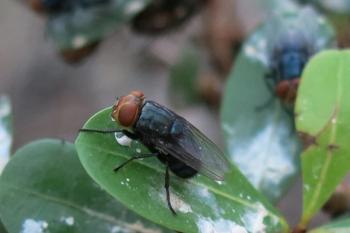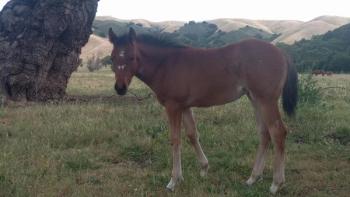
Consistency, options best allies for dealing with recalcitrant equines
Las Vegas, Nev.-Most horses won't disappoint you, says Glenn Anderson, DVM. "If you go looking for a fight, you better pack a lunch. They're gonna give you one."
Las Vegas, Nev.- Most horses won't disappoint you, says Glenn Anderson, DVM. "If you go looking for a fight, you better pack a lunch. They're gonna give you one."
Time, patience and consistancy are all that's needed to tame even the most unruly horse, according to Dr. Glenn Anderson. Try to relate to the animal, communicating with body language. Recognizing the meaning behind a horse's actions is half the battle. Play off its gestures and work from there.
Whether it's problems loading a horse into a trailer, inserting nasal tubes or overcoming performance issues, the Oklahoma rancher, veterinarian and equine consultant has the solution. In February, Anderson shared his 25-plus years of experience, stories and advice during a seminar at the 74th Annual Western Veterinary Conference here.
"First things first," Anderson warns the crowd. "There's an attorney behind every bush, so I advise you make your clients sign a consent form before working on any animal."
One hoof in the trailer
Loading a scared horse in a trailer can be frustrating, to say the least. The keys to success, Anderson says, lie in being consistent and giving options.
For example, if a horse runs backward when at the mouth of a trailer, keep it running, he says. Don't reward disobedience by stopping. It's uncomfortable for a horse to run in reverse and it soon will realize the better option is to stand still.
Low resistance techniques also work, Anderson says. Don't forcibly pull or push a horse because the horse then learns it's stronger than you are. Instead, use a long, sturdy pole with a plastic bag tied to the end and aggravate the horse by making noise with the bag. Keep it up until the animal shows the smallest attempt to load. Then reward it.
"Once again, it's about options," Anderson says. "If the horse lowers his head and points his ears forward and into the trailer, that's an attempt to load and you should stop the aggravation. It's important not to miss the signs."
Tips for tube insertion
Anderson criticizes the common practice of twitching a horse on the nose to force nasal gastric tubes.
"It's not that I'm some kind of humanaic," he says, "but it's the easiest way to get hurt. When a horse gets ready to blow up on a twitch, he gives no warning."
Instead, start by rubbing a finger up and down the animal's septum, getting the horse familiar to touch. Once accepting, little or no restraint is needed to insert the tube, Anderson advises, showing demonstrations from home videos.
The real "bad boys"
"What you really have to watch out for are the horses that mean to hurt you," Anderson says, "so common sense must always prevail. Don't put yourself in a situation where one of you is going to get hurt or one of you is going to get sued."
To start, he says, tie up an aggressive, dangerous horse for up to 22 hours a day, releasing the animal twice daily to eat and drink. "I don't believe there's a horse that can't be tied. You've got to make it so their entire existence depends on you, and they realize that as soon as you show up, things start to get better.
"By the third day, when you come around, they'll start nickering," he says.
Yielding to pressure, accepting restraint
But some horses refuse to stand tied quietly, Anderson adds, digging holes or striking and kicking. That's when hobbles come into play.
"Hobbles turn your horse into a nicer citizen," he says. "When used properly, there can be a lot of learning going on and they're teaching it all to themselves."
Anderson recommends the Australian hobble, a four-limb contraption that at first looks impossible and dangerous to use.
"It's a little scary until you've seen them put on," he says. "Then you'll see that they're not going to hurt themselves."
No overnight miracles
Taming and training a horse doesn't happen in a day. It takes time to build a relationship with the animal, which undoubtedly will cause stress and frustration, Anderson says. "Always leave your temper at home, because you're doing nothing but scaring the horse by getting mad.
"Doing the basic groundwork and starting at square one rather than at graduate school is the way to get horses to do what you want," he adds. "Give your clients tips to work toward in between the times when you have to come. It could make all the difference."
Newsletter
From exam room tips to practice management insights, get trusted veterinary news delivered straight to your inbox—subscribe to dvm360.






